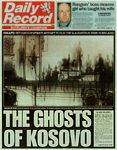
 |
|
©
Pedro Meyer 1999
|
|
"He had been walking for two days, in someone else’s clothes, trying to find a way of out of Kosovo when he came across a photograph lying, face up, by the side of the road." "He looked, and looked again, at the pretty fair hair and blue eyes of the smiling child staring back at him from the crumpled picture. It was his daughter." Chris Stephen in Morine , Albania writing for the Evening Standard in London, recounts as " Bashkim’s mind was by then close to shutdown. Four days ago Serb paramilitaries in black balaclavas had arrived in his village, Krajlan, near the central Kosovan town of Klina. "They had rounded everyone up, separating the men from the women and children, and Bashkim had feared the worst. With about 500 men he was ordered into a field outside the village and they were all told to strip. The men’s clothes were piled in a heap, but the expected executions never took place." "Instead the men spent a sleepless night naked in the rain, before being divided into two groups. Ninety were separated and led away. Bashkim has no idea about their fate. He, like the rest, was told to put on clothes — any clothes, from the huge sodden pile- and leave. They did so quickly. As they walked away, machine gun fire rang out from the direction where the ninety had been marched. "Bashkim never found out what happened to them. By the following morning he was with 150 of the others, feeling tired, hungry, and fearful of bumping into more Serb paramilitaries when he came across the photograph. A little further up the trial, he noticed another - of his uncle- and further still one of his wife. And then he understood. " His wife, in her desperation to guide her husband out of danger had torn up the family photo album leaving pictures to mark a path he could follow out of the country to safety. Soon other men found similar photographs on the ground or stuck to rocks and bushes, all marking a paper trail along a series of mountain tracks which led them eventually to the Albanian frontier.
In one instance we have the ingenuity of humans using photographs in an almost fairy tale manner by leaving a trail of pictures amidst the war stricken region of the Balkans; in the other instance we have high tech x-ray images of an entire truck to detect the presence of humans as they are hidden away among a load of wares. It is uncanny how photography is at the heart of both stories. Images are with us every where in these wars, they are to be found on the monitors that pilots use to scan what they are going to bomb on the ground 15 000 ft. below or on the television newscast reporting on those same events. Pictures are used by the military establishment to confirm that their missions have been accomplished. The news industry use images to communicate to the public what is happening. Pictures are taken of refugees for identification papers. But all this we more or less already know, what struck me however as quite different and surprising this time was to receive an email from someone in Macedonia, in the middle of the war torn Balkans, commenting on his visit to ZoneZero as he was looking at photographs. ---------- From:
igor kocoski <buv@mol.com.mk> I already read your magazine. It is wonderfull. I am Dragi Nedelcevski from Tertovo, Republic of Macedonia. My E-mail adrress is: nedelcevski.yahoo.com I am doing b&w and colour photography. Maybe i shall send some to You!
We do not know who is putting up these pages, which contains "the Serbian side" of the story, but above all else, we find that the photographs mostly not seen and published in the west are in themselves a very important source of information. Again, we find the role of photography to be ubiquitous, and that in spite of bombs and black outs, the internet keeps sending out such messages to allow us to form a better understanding of all that is going on as we seek information from diverse sources and of all persuasions. |
